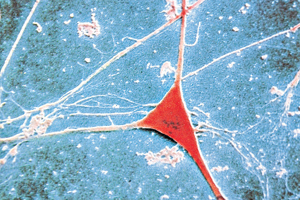Neurons are nerve cells that are specially adapted to receive impulses, which are processed and transmitted through electric signals. Their structure is split into three parts:
– Cell body or soma: it is made up of a nucleus, a nucleolus and cytoplasm. It is the most vital part of the neuron.
– Dendrites: they are short prolongations that constitute the entryway for stimuli.
– Axon: it is the tail of the neuron as well as the area that conducts and releases information. Each nerve cell has an axon, which has multiple terminals known has buttons or axon buttons. They come into contact with other neurons, a process known as synapse.
Synapse
Neurons communicate with each other through a process called synapse. It occurs when a nerve impulse goes down an axon all the way to the synaptic button and releases chemical substances that make the next neuron in line respond. The path of this impulse only goes one way. Depending on the kind or class of neuron, the impulse can go from an axon to another cell body or from a dendrite to an axon.
There are chemical intermediaries known as neurotransmitters. They are chemical substances neurons release during the synapse process to transmit nerve impulses. The most well-known ones are acetylcholine and noradrenalin, which are secreted by the axon terminals of a transmitter neuron and perceived by a receptor neuron, which produces a new impulse, and there on and so forth. The three most common types of synaptic transmission are:
– Axodendritic synapse: it is the most common one, and it is performed between the axon of a neuron and the dendrite of another neuron.
– Axosomatic synapse: it takes place between the axon of a neuron the cell body of another neuron.
– Axoaxonic synapse: it occurs between the axon of a neuron and the initial part of the axon of another nerve cell.








